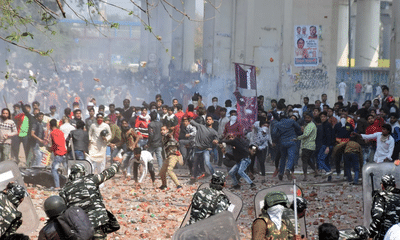Delhi Riots 2020: Police Tell Supreme Court Violence Was a Pre-Planned Conspiracy to Destabilize the Government
A major revelation has emerged in the 2020 Delhi riots case. According to a sworn affidavit submitted by the Delhi Police in the Supreme Court of India, the riots were not spontaneous acts of violence, but rather part of a larger conspiracy aimed at destabilizing the central government and tarnishing India’s image globally. The affidavit claims the unrest was orchestrated under the guise of protesting the Citizenship (Amendment) Act (CAA) and was designed to exploit communal fault lines for political gain.
The police have alleged that the riots were carried out as part of a “regime change operation,” strategically planned to weaken the nation both internally and diplomatically. Notably, the violence erupted at the same time as the visit of then-U.S. President Donald Trump, suggesting, according to police, an intent to damage India’s international reputation during a globally significant moment.
Police: Riots Were Deliberately Timed, Not SuddenThe affidavit highlights that the riots, which claimed 53 lives and left over 700 people injured, were triggered in northeast Delhi in February 2020 amid the anti-CAA protests. More than 750 FIRs were registered, and the property loss amounted to hundreds of crores of rupees.
The police argue that this was not limited to Delhi; rather, the unrest was meant to spread nationwide. Investigations revealed pan-India connections involving similar protest patterns, slogans, and inflammatory speeches in different parts of the country — indicating a coordinated plan, not isolated acts of violence.
Accused Using Legal Delays, Says PoliceAccording to the affidavit, the police have accused key defendants — including Umar Khalid, Sharjeel Imam, Meeran Haider, and Gulfisha Fatima — of deliberately stalling court proceedings. The document refers to multiple “frivolous applications” filed by the accused to delay the framing of charges in the trial court.
The police described this as a “brazen abuse of process,” claiming that if the accused cooperated, the trial could be concluded based on testimony from roughly 100–150 key witnesses. Instead, these repeated bail and interim applications have, according to investigators, significantly slowed judicial progress.
UAPA Charges and Opposition to BailThe affidavit further notes that the accused are being prosecuted under the Unlawful Activities (Prevention) Act (UAPA), India’s anti-terror legislation. The police have opposed bail, asserting that the accused have failed to disprove the charges and may attempt to influence the proceedings if released.
The affidavit stresses that terror-related offenses under UAPA rarely qualify for bail, and given the scale and nature of the alleged conspiracy, allowing the accused to walk free could compromise the fairness of the trial.
Timeline: Key Developments in the 2020 Delhi Riots Case-
February 2020: Communal violence breaks out in northeast Delhi amid anti-CAA protests, resulting in 53 deaths and hundreds injured.
-
August 2020: Activist Sharjeel Imam arrested.
-
September 2020: Umar Khalid and others taken into custody under UAPA and IPC provisions.
-
2022: Trial court rejects multiple bail pleas by the accused.
-
2022–2024: Several accused approach the Delhi High Court challenging the denial of bail.
-
July 9, 2025: Delhi High Court reserves its verdict on their bail petitions.
-
September 2, 2025: High Court dismisses bail applications of nine accused, including Khalid and Imam.
-
October 13, 2025: Sharjeel Imam files an interim bail plea before the Karkardooma Court, seeking permission to contest the Bihar Assembly elections.
The affidavit emphasizes that the riots were a systematic attempt to attack India’s sovereignty and integrity, using dissent against the CAA as a weapon to create polarization and unrest. It asserts that certain groups intentionally exploited public sentiment to provoke communal disharmony and disturb national peace.
Authorities have maintained that this was not a protest gone wrong but a well-coordinated campaign designed to discredit the government domestically and internationally. The timing of the violence during a high-profile diplomatic event further underscores, according to the police, the strategic intent behind the unrest.
ConclusionThe Delhi Police affidavit adds a new layer of complexity to one of the most debated incidents in recent Indian history. As the Supreme Court reviews the findings, the revelations raise significant questions about the scale of planning, intent, and accountability behind the 2020 Delhi riots.
With the next phase of the trial expected soon, the case continues to draw national attention — symbolizing not only the legal pursuit of justice but also the broader challenge of protecting democratic dissent while preserving law and order.
You may also like

'She sacrificed her career': Former Biden adviser says JD Vance should apologize publicly; 'For being a Christian?' MAGA fires back

'Worst part' of Mikel Arteta's job, Arsenal injuries latest, Gunners trio 'desperate' to play

2nd T20I: Hazlewood And Marsh Help Australia Beat India By Four Wickets, Take 1-0 Lead (ld)

Social entrepreneur who worked with kids killed after holding 17 hostages in Mumbai

EV Stocks Defy Market Weakness: Mercury EV-Tech Surges Over 7% Amid Broader Market Decline







